2022 State Of Remote Work
Data from over 2,000 remote workers around the world looking at the shifts and evolution of remote work in 2022, along with the benefits and struggles it brings.

A report by Buffer in partnership with Nomad List and Remote OK
We have tracked the evolving state of remote work since 2018. That year, remote work was gaining popularity but still overall uncommon. At Buffer, we’ve built our business around a culture of having a fully distributed team: we currently have teammates in 15 different countries and many of our customers - creators and small businesses who use Buffer to help them build their brand online - tell us that they work remotely as well.
This year, in our fifth report, the world of remote work is entirely different. With the COVID-19 pandemic having pushed many individuals and businesses into working primarily from home or shifting their work model entirely, the conversations around remote work have changed.
Do people still like remote work? How is remote work truly happening in 2022? Have the benefits and struggles of remote work shifted? What is the continued impact of the COVID-19 pandemic on remote work? And what does remote work mean for career growth and pay?
In the 2022 State of Remote Work report, we surveyed 2,118 people hailing from 16 different countries to answer these and many more questions.
In this year’s report, just over half (52 percent) are employees while 42 percent are independent consultants or freelancers. Of the employees, 74 percent work in companies with 500 or fewer people. A majority (57 percent) have been working remotely for two years or fewer, 27 percent for three to 10 years, and 6 percent have worked remotely for more than 10 years.
We also saw a wide range of identity and experience in respondents: 37 percent identify as female, 61 percent as male, and 1 percent as non-binary. Further, 21 percent identify as Hispanic / Latino / of Spanish origin, 16 percent as Black or African American, and 60 percent as white. A small number (10 percent) preferred not to disclose their racial identity.
Outside of geography, race, and gender, 6 percent identified as having a chronic disability or illness and 38 percent identified as parents or guardians. Respondents also work in a mix of industries and represent all generations, though they tend to be millennials working in either the software or marketing, media, and publishing industries.
This report offers insights into:
- How people truly feel about remote work
- The work structures (and locations) people have adopted
- The benefits and struggles people see coming from remote work
- How COVID-19 continues to affect remote workers
- How remote work impacts career growth, pay, and performance
Our goal in 2022 was to better understand how remote work is changing and evolving as well as what people want for the future of remote work, asynchronous work, and newer movements like the 4 day work week. To gather this data, we partnered with Remote OK and NomadList who helped us reach a global audience with this survey.
Let’s dive in.
Overview
Every year we ask a few questions that get to the bottom of overall happiness with remote work, and this year we also looked at how organizations are planning to operate remotely (or not) in the future. Here’s what we found:
Employees Overwhelmingly Recommend Remote Work
The first thing we wanted to understand was how people felt about remote work, and the results are clear: people overwhelmingly recommend remote work and would like to continue working remotely.


We’ve asked this question in the past to similar results. This year, we specifically asked about the remote work experience as well — and the large majority of respondents have positive experiences with remote work in addition to recommending it.

Liking remote work could correlate to the fact that 93 percent of employees say their organization trusts them to work remotely. And when we asked why people liked remote work, the most popular answer was flexibility in how people can spend their time. Despite overall positivity about remote work, though, people have concerns as well, with unplugging from work at the end of the day and feeling connected to coworkers being the key struggles.
We also noticed that the remote work community seems to be split on whether remote work can hurt or stall career progression. Some executives have voiced concerns that remote work stops employees - especially more junior employees - from making connections and learning from peers, both of which can occur naturally in a co-located office. However, the majority of respondents (55 percent) don’t believe that career growth is more difficult for remote workers. Fourteen percent believe that remote work makes career progression less difficult and 41 percent believe it has no impact at all.

More Organizations are Planning a Remote Future
For the first time in the State of Remote Work, we asked remote workers about the kind of work structures they’d work under — most are either fully-remote or remote-first. The difference is that remote-first means operating closely to fully-remote companies with a few exceptions, for example keeping some office space for employee gatherings.
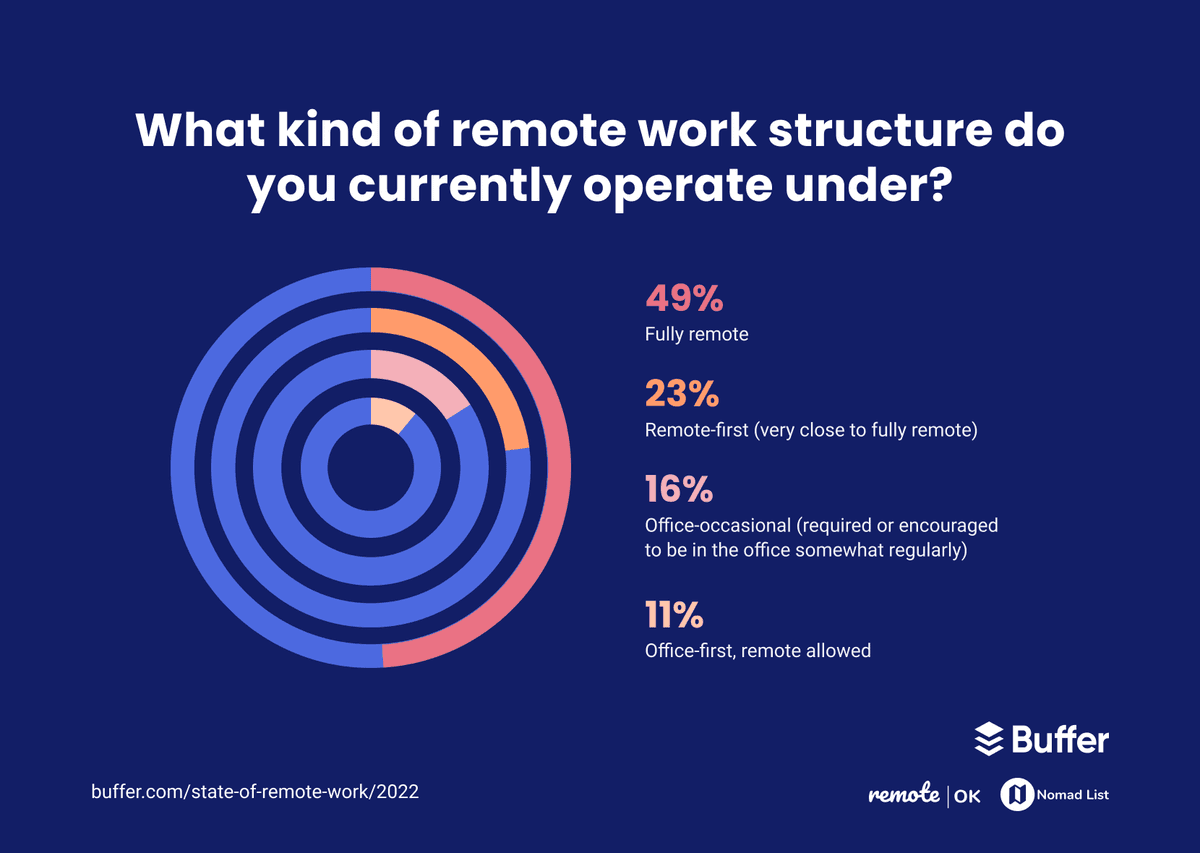
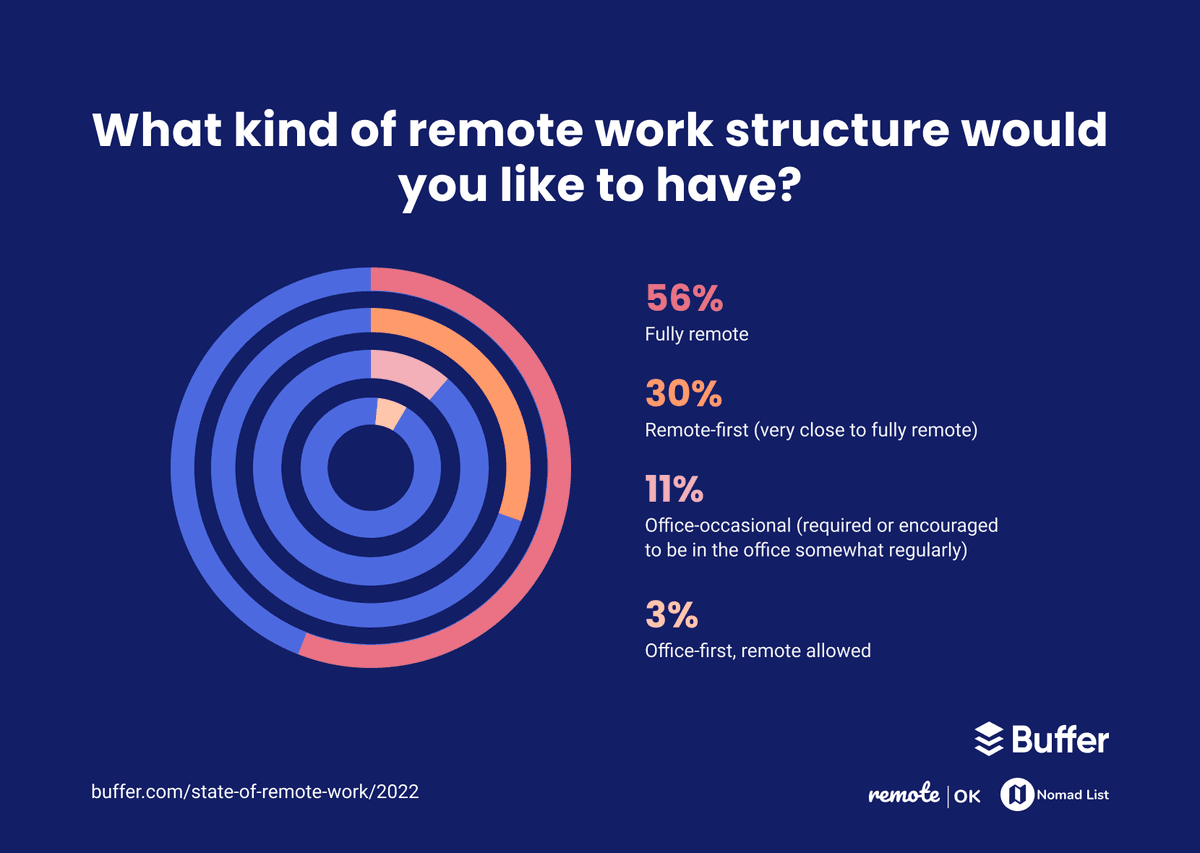
It also seems employees and organizations are aligned on future desires: 86 percent of employees either wanted fully-remote or remote-first work environments going forward while a similar number - 72 percent - said their organization is planning for some form of permanent remote work going forward. Notably, this is a 46 percent increase compared to us asking the same question in 2021.
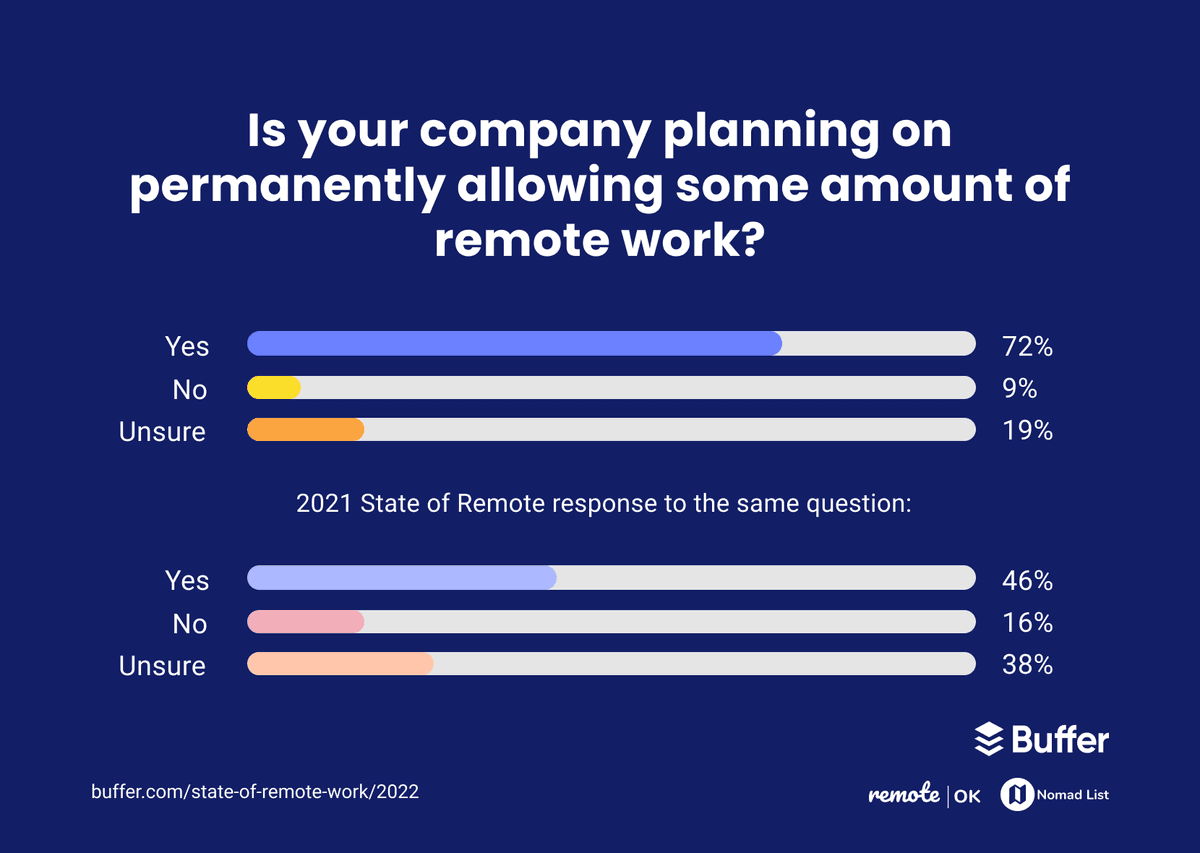
On top of more companies planning for permanent remote work, it also seems there’s more certainty about working remotely (or not) going forward. In 2021, 38 percent of people said they didn’t know if their company had remote work plans for the future. In 2022, that number dropped to 19 percent.
There’s clear alignment here between the remote work experience being overall positive, and organizations responding to that by continuing to operate remotely in at least some capacity. Next up, we’re going deeper into the data with how work happens in 2022, the benefits and struggles of remote work, the continued impact of COVID-10, as well as the topic of career growth in a remote environment.
How (Remote) Work Happens in 2022
Remote work can mean something different depending on the individual or business. Our goal this year was to better dig into the nuances between different types of remote work, and not just look at remote versus co-located work.
The Structures Behind “Remote”
The first question we asked was what kind of remote work structure people currently operate under. Nearly half (49 percent) work fully remote, nearly a quarter (23 percent) work remote-first, and a further 16 percent work “office-occasional.” Only 11 percent are office-first with remote work allowed.

To further understand the sub-structures people want to work under, we asked about three common policies: flexible working hours, no-meeting days, and a four-day work week (4DWW).
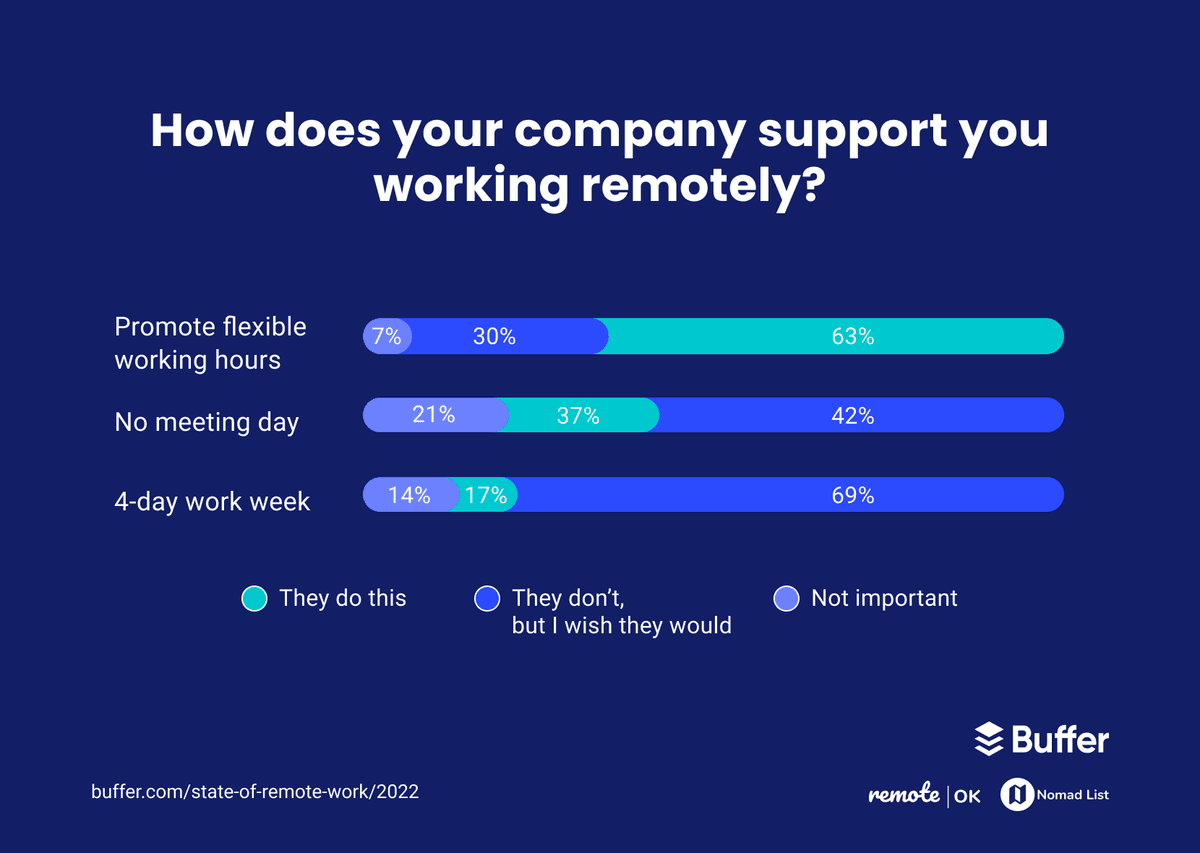
The 4DWW was the least common policy, but the most desirable. Only 17 percent of people say their organization has a 4DWW while 69 percent say they wished their organization had this policy in place.
We’ve been operating on a 4DWW at Buffer since May 2020 and aren’t planning on going back to a five-day work week. In a recent team survey, 91 percent of our team report they are happier and more productive working four days a week. We also approach the 4DWW as a rule of thumb, but not set in stone. Many employees, particularly working parents, have chosen to work five shorter days versus four full days because it offers more flexibility for their families. Further, we don’t schedule any company communications on Fridays, so some people like working a little on Fridays as an “overflow day” if they need to.
“The four-day work week is a solidification of a truly flexible and results-oriented workplace,” said Nicole Miller, the Director of People at Buffer. “We put a lot of trust in our teammates to accomplish their goals and manage their schedules accordingly, and the four-day work week has proven to be a powerful benefit in also attracting talent. We believe the four-day work week is the next evolution of human-centered workplaces.”
Where People Want to Work
The luxury of where one works is supposed to be a key benefit of remote work. However, the COVID-19 pandemic forced most people to work from home for the better part of 2020 and 2021. To understand what people truly want in a non-pandemic world, we compared results from the 2019 State of Remote Work with a question about post-pandemic planning.
In 2019, we found that 84 percent of people chose to work from home. The remaining 16 percent were split between coworking spaces, coffee shops, libraries, or other locations.
This year, we asked where people would prefer to work if the pandemic ended today. Just over half (59 percent) say they wanted to primarily work from home and 41 percent want to work primarily from other locations. This shift could be the result of COVID-induced wanderlust, but could also be the result of an increased awareness of (and access to) on-demand coworking spaces.

A Question of Asynchronous Work
Asynchronous work - work that doesn’t happen at the same time for everyone - is a big conversation for remote workers as it can be a powerful way for teams to get work done without being in meetings all day. Asynchronous (“async”) work is often called the solution to time zone issues and “that meeting could have been an email” responses. However, it’s not yet the standard: only 38 percent of respondents say their company has an async-first policy.
Note: In this report we talk about asynchronous-first. Most proponents of async work advocate for async-first, which means you default to asynchronous methods but will have synchronous elements for specific types of work or team bonding activities.
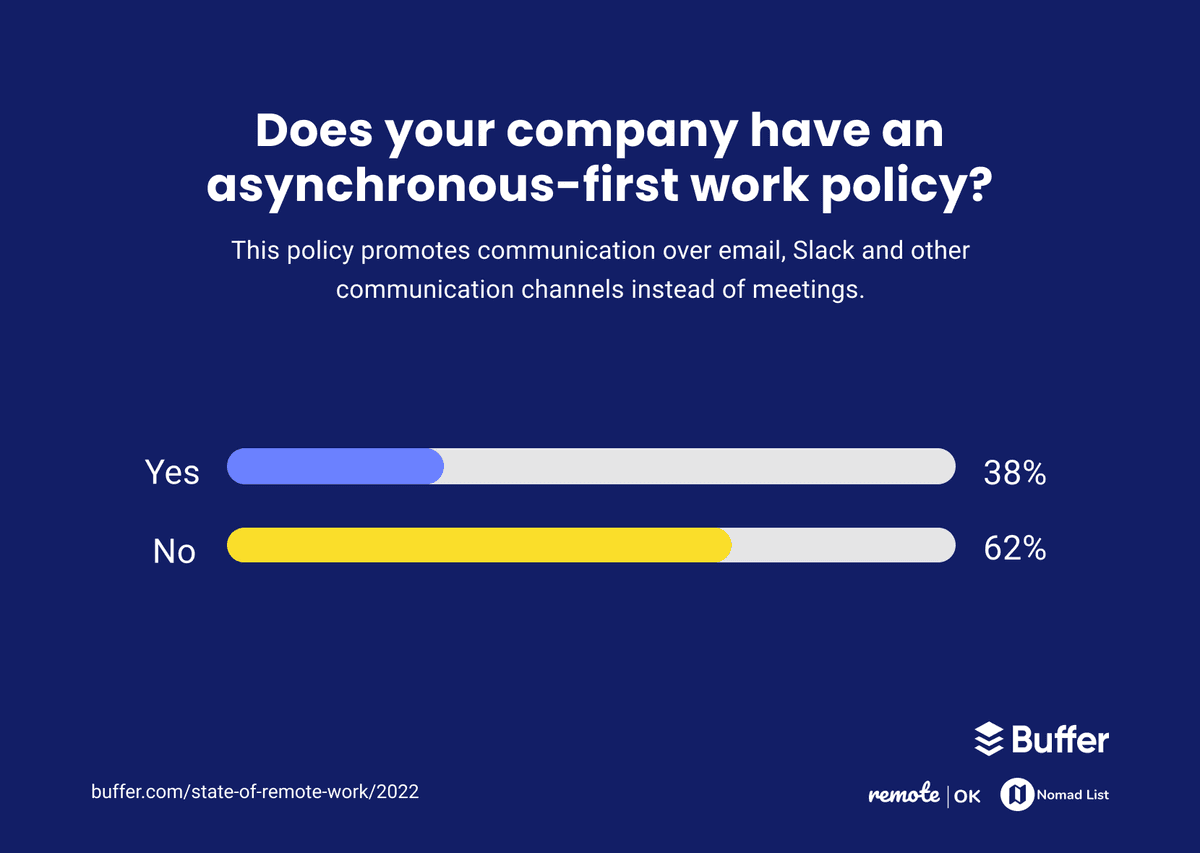
When we asked whether people want async-first policies going forward, 52 percent said yes while 14 percent said no and the remainder said they weren’t sure.
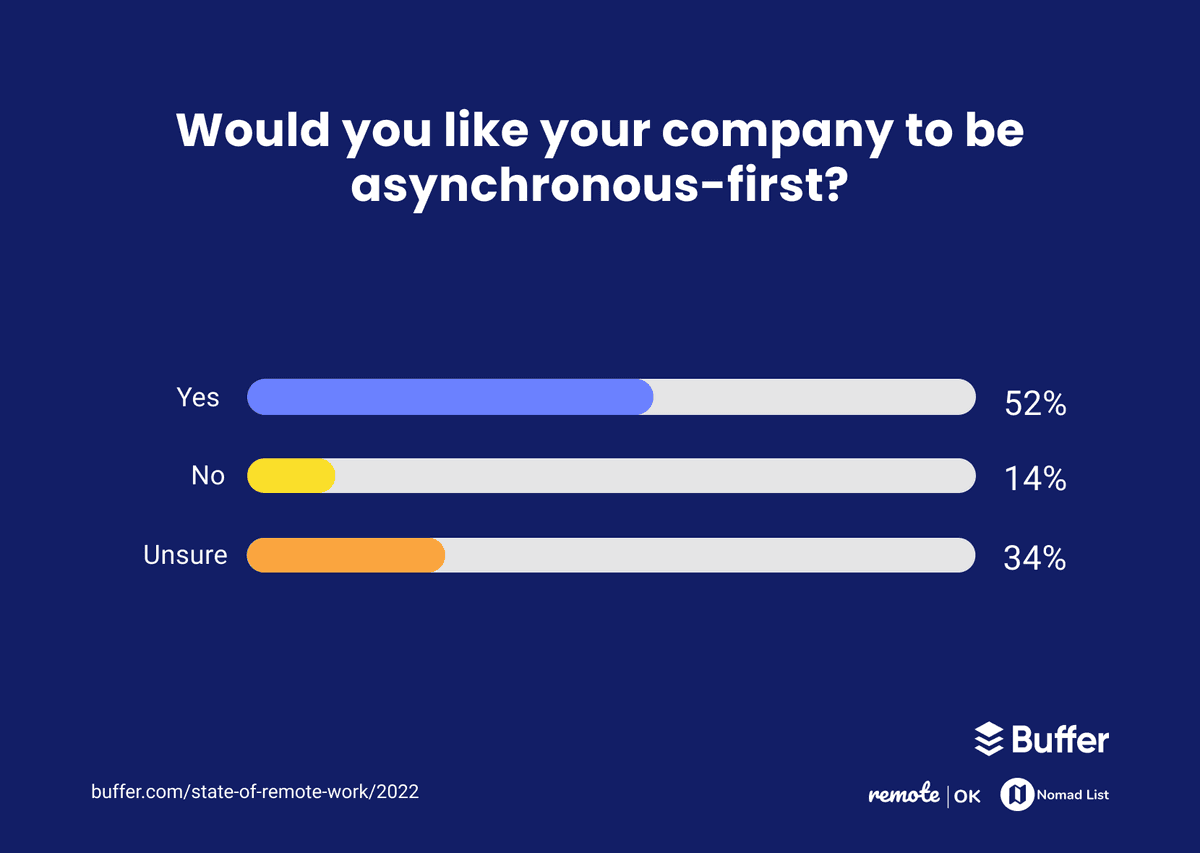
The question of implementing async-first work is not just about cancelling meetings and hoping for the best. To make this change effectively, companies need to think about how they communicate and what other tools or systems they could use. But in this conversation, two good things emerge: first is that many existing workplace tools are async-friendly. Second is that there’s strong employee support for async-first work, meaning leadership would have groundswell support and can ask employees for ideas on how best to structure the workplace.
The Benefits and Struggles of Remote Work
The top benefits and struggles can be incredibly insightful in this report every year. This year, we allowed remote workers to select multiple benefits and struggles in the survey, and then asked for the top one, giving us a more complete picture of what is at the top for each area.
Flexibility Remains the Top Benefit
The top two benefits of remote work people cited are perhaps unsurprising: 67 percent say flexibility in how they spend their time and 62 percent say flexibility to choose their work location.
What’s particularly interesting are the benefits that come next: having more time because they don’t commute, flexibility to live where they choose, better financial outcomes, and the ability to better focus on work.
On the financial side, the most obvious example is the money we spend commuting to, and eating at, the office: we spend $2,000 to $5,000 commuting per year, according to FlexJobs, and $2,700 on lunches annually according to Visa. With remote work all but eliminating a commute (except perhaps in rare circumstances), and giving people the opportunity to make lunch at home, people keep more of the money they earn, making remote work tantamount to a raise without a company having to change anyone’s salary.
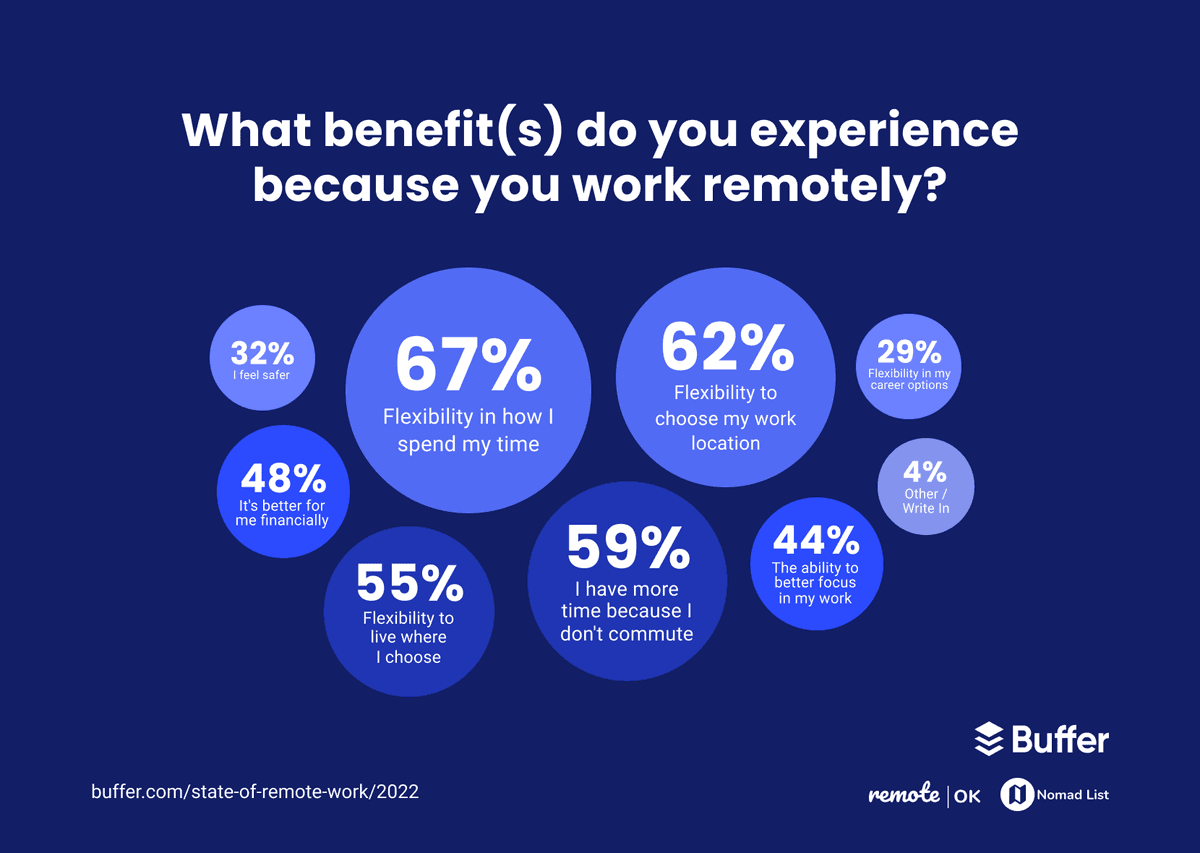
Remote work can also offer benefits to people for whom going into an office can be difficult. Forty-four percent of respondents who identified as having a chronic disability or illness cited their personal circumstances as a reason they pursued the flexibility of remote work and 76 percent of working parents/guardians said the same thing.
Unplugging and Loneliness are Main Struggles of Remote Work
As with anything, there are both benefits and struggles with remote work. The top two concerns highlighted this year were not being able to unplug from work and struggling with feelings of loneliness. Both concerns that span outside of simple remote work and may reflect a larger societal struggle due to the COVID-19 pandemic continuing to impact how we interact with friends and family.

“With office work, you automatically make friends in real life by working together”, said Pieter Levels, the founder of Nomad List and OK Remote. “With remote work the same happens. But now these people can be all around the world. One of the solutions is to concentrate remote workers in specific hubs. Other solutions are to work from local coworking spaces and cafes, and actively work on building the social life we want. But as remote workers, we need to be more proactive at doing that, because unlike traditional office work, with remote work getting friends physically near you doesn't happen by itself."
COVID-19 and Remote Work in 2022
A big shift we say this year is that it is clear that more organizations have made up their mind about remote work. In our survey, 72 percent of respondents who now work remotely due to the COVID-19 pandemic said their company is planning on permanently allowing some amount of remote work in the future. In 2021, only 46 percent said yes and 38 percent were unsure.

The biggest changes that occurred for people making the shift to remote work in the last few years is how they collaborate and communicate, which was the same top choice as in the 2021 State of Remote Work. What’s different about last year to this year is that in 2021, 22 percent of people said only their work location changed, but nothing else. In 2022, only 8 percent said nothing changed (with the exception of work location).
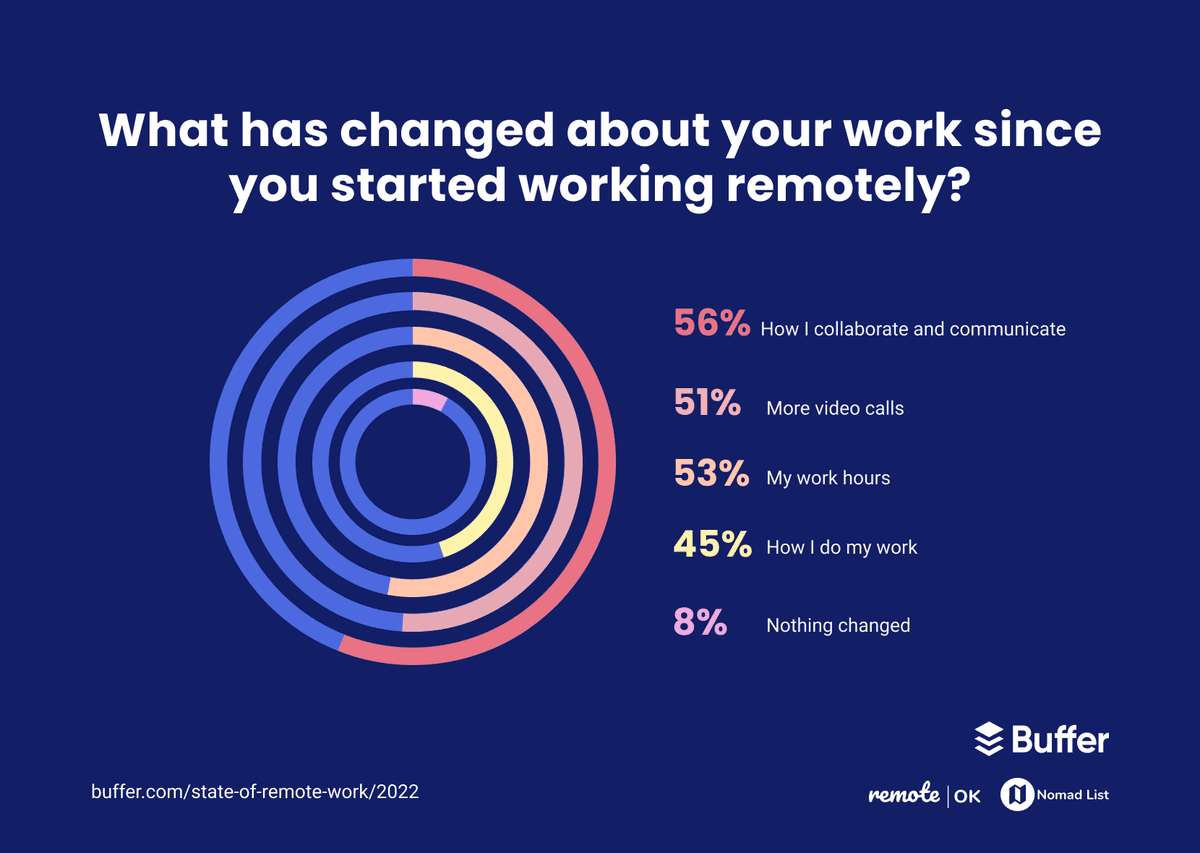
For Some, Remote Work Means More Meetings
One criticism of the shift to remote work is that remote work forces employees to work more hours. There seems to be some truth to this statement: 40 percent of respondents who shifted to remote work due to COVID-19 said they are working more since they started working remotely. However, 20 percent say they are working less and 40 percent say they are working the same number of hours, meaning the majority do not seem to fit into the narrative that remote work always means more working hours.
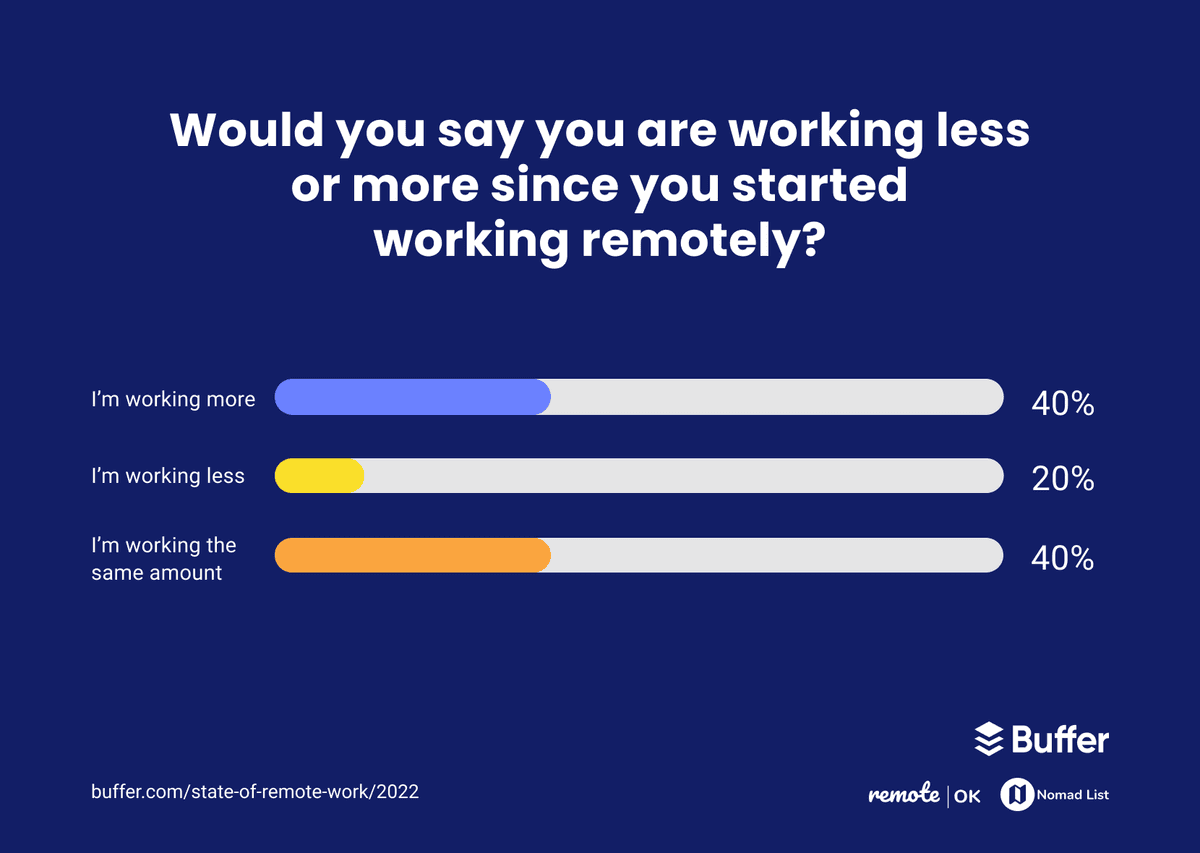
What does seem to increase a lot with remote work is meetings. The majority (61 percent) of people said they are in more meetings as a result of COVID-forced remote work.
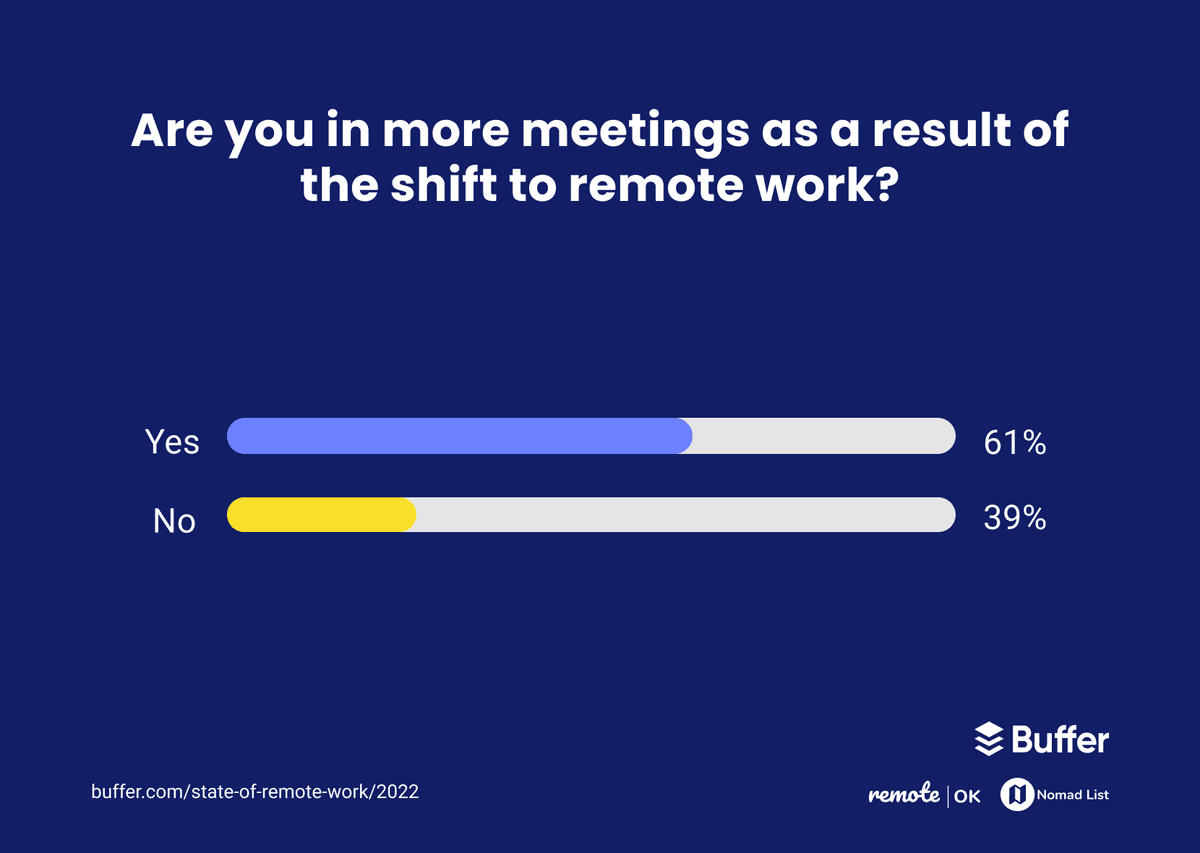
Feeling Disconnected at Work
Despite, in some cases, being in more meetings at work, that interaction may not have led to a feeling of connection. A small majority (52 percent) of people who started working remotely due to COVID-19 feeling less connected to their coworkers. The other remaining 48 percent say it’s either had no impact (30 percent) or they actually feel more connected (18 percent).
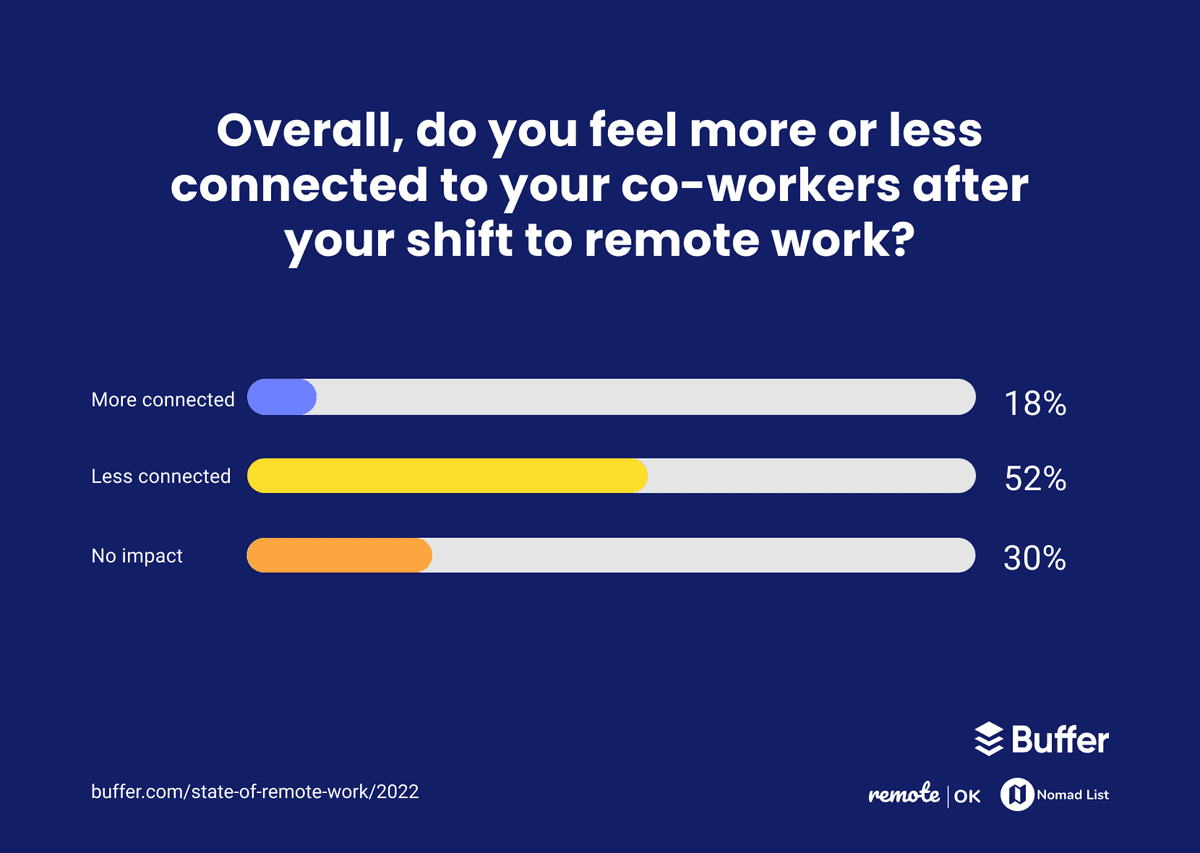
One part of building connections at work is the systems that employers put into place to foster it. It seems that most companies cover transactional basics like technology for remote collaboration. However, many appear to fall short when it comes to team building and team connection activities.
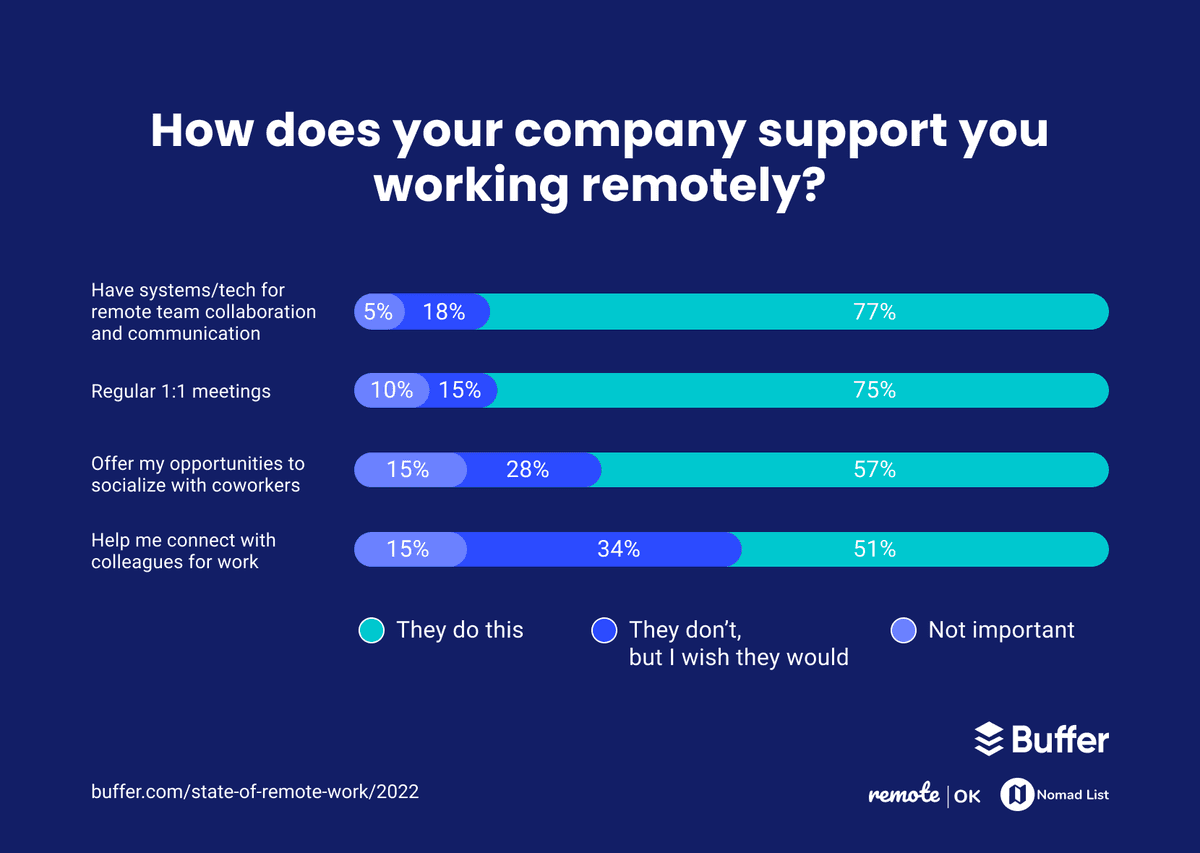
“Connection and teammate engagement in a remote environment requires twice the effort of in-person workplaces,” said Nicole Miller, the Director of People at Buffer. “Individuals and companies need to orchestrate opportunities for meeting, discussions and fun. While this happens more naturally around a physical water cooler, the digital space requires coordination and sometimes a little bit of strong encouragement to overcome the social barrier of talking to teammates you otherwise don’t have much overlap with in timezone or work responsibilities.”
More Job Excitement
Despite some loss of feeling connected, and possibly more meetings, the majority of people (62 percent) say they are more excited about their work since COVID-19 forced them to start working remotely, and as we saw in the beginning of this report respondents overwhelmingly want to continue working remotely. Our takeaway here is that although there are definitely some challenges with organizations who have switched to working remotely, the overall benefits and general flexibility of remote work outweigh the concerns.
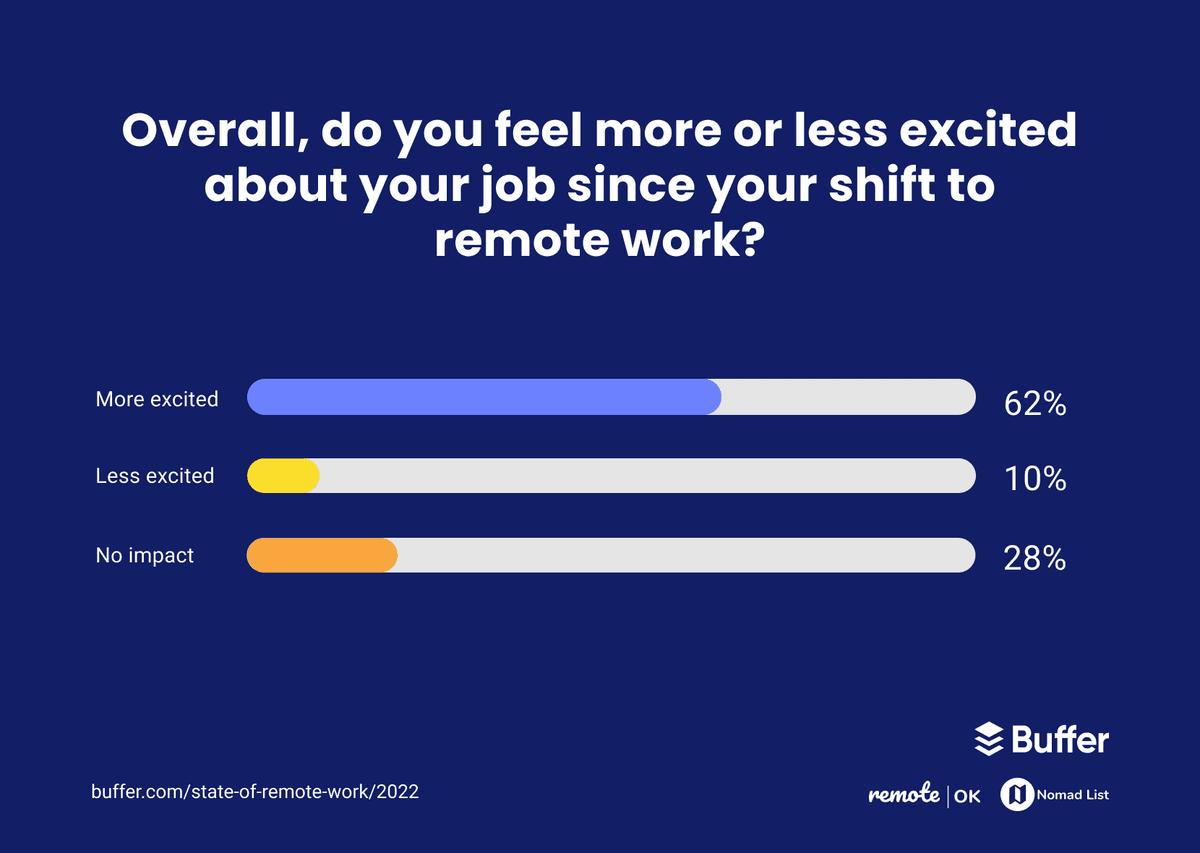
Career Growth and Salaries in a Remote World
Remote career growth and remote pay have been two other widely discussed topics as remote work has become more widespread.
Is Remote Career Growth More Difficult?
It has been suggested that remote work could impact career trajectories for young people who won’t get the mentorship and informal networking elements that come from working in an office. However, most respondents don’t seem to share that concern. In our survey, the majority (55 percent) said that remote work either had no impact (41 percent) on their career trajectory or actually made career growth less difficult (14 percent).
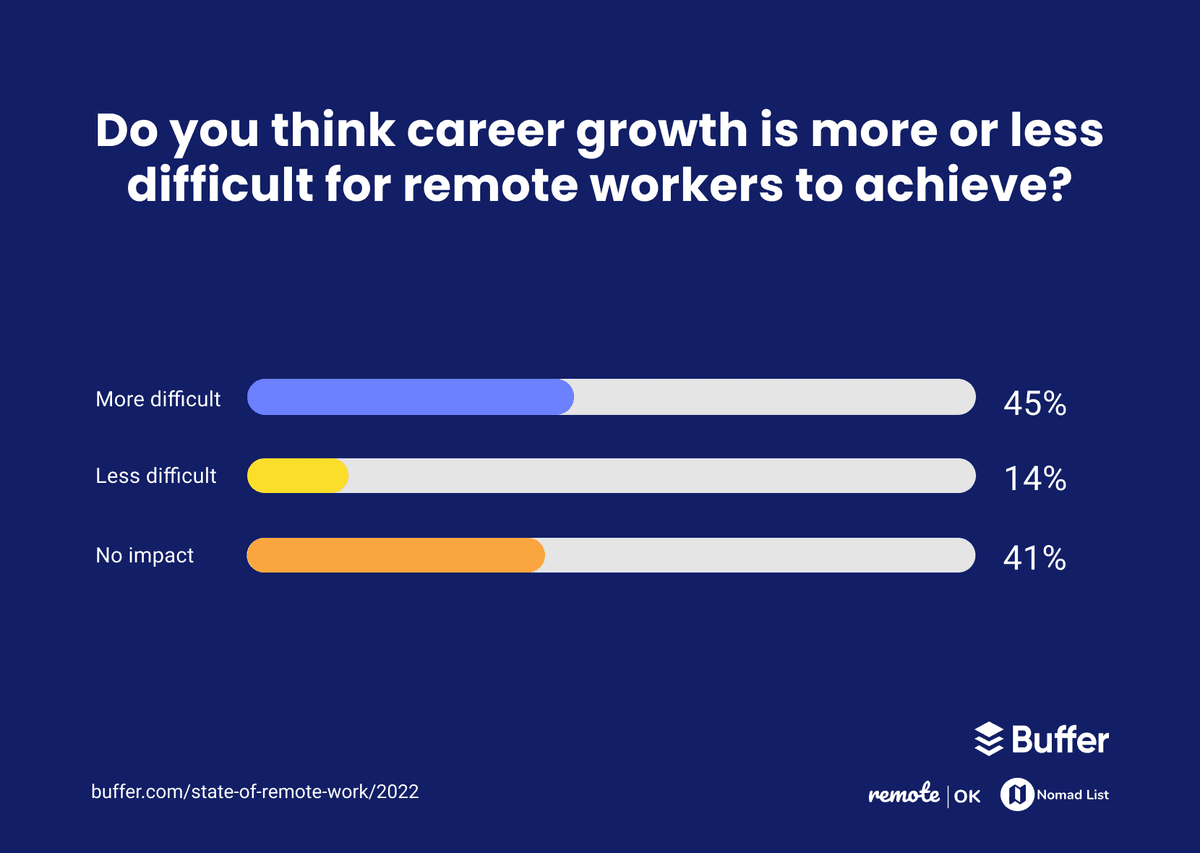
While proponents of remote work suggest the ability to work for any company in the world makes career progression easier, that feeling doesn’t seem to be enough for the 45 percent who feel remote work makes career progression more difficult. Looking more into this group, it looks like companies themselves have room for improvement. When asked whether their company provides career growth opportunities, 44 percent of survey respondents said their organization doesn’t but they wished it would. With this number in mind, the idea that 45 percent say it’s harder to advance one’s career while working remotely might be more due to a company not supporting career growth vs. something inherent about remote work.
How Location Impacts Salaries
Another conversation in the world of remote work is how to pay remote workers — should salaries be dependent on where someone lives?
Just under half (40 percent) of people said their pay is tied to a specific location. Just over a third (38 percent) said pay was not tied to a specific location, and 22 percent said they were unsure.
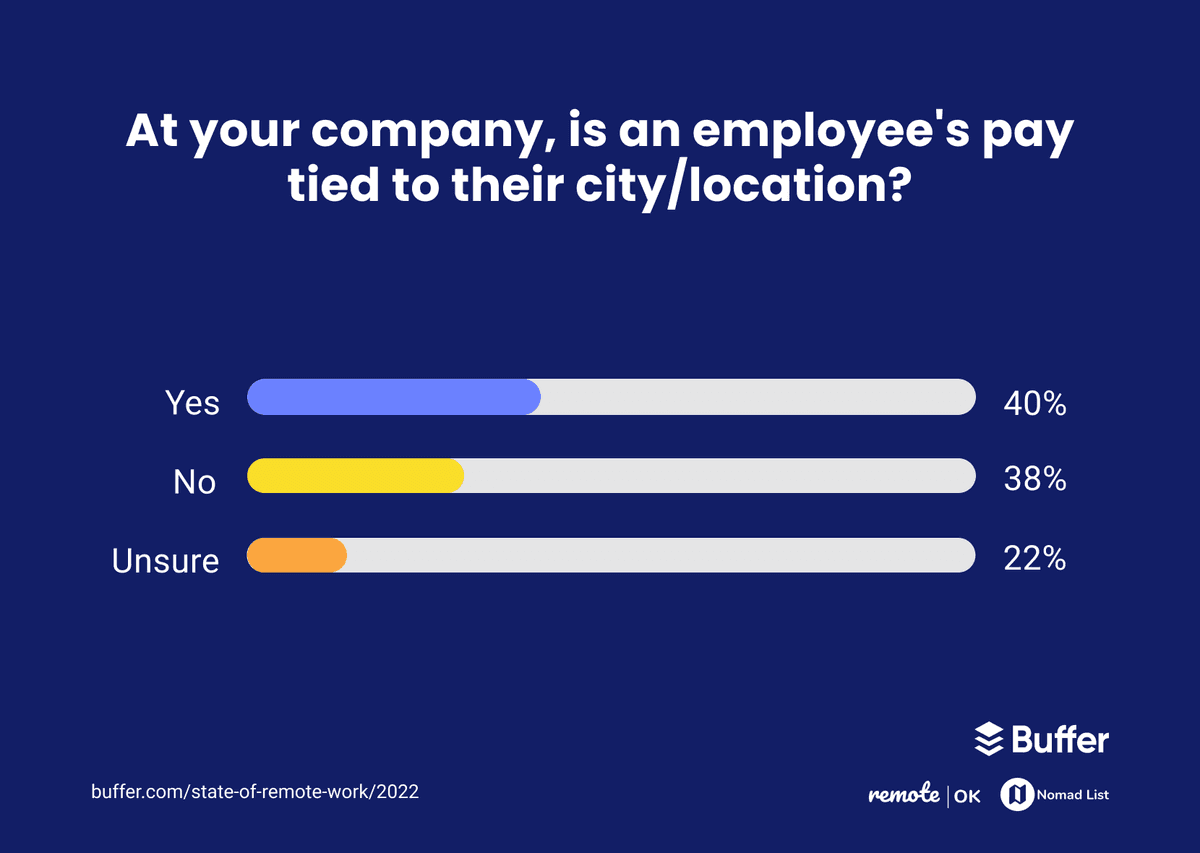
It also seems that people are split on whether they support pay being tied to location, with 46 percent saying pay should be tied to a geography while 54 percent said it shouldn’t be. When it comes to generational differences, Gen Z is more likely to approve of pay being tied to a specific location while Millennials, Gen X, and Baby Boomers are less likely to approve of pay being tied to a specific location.
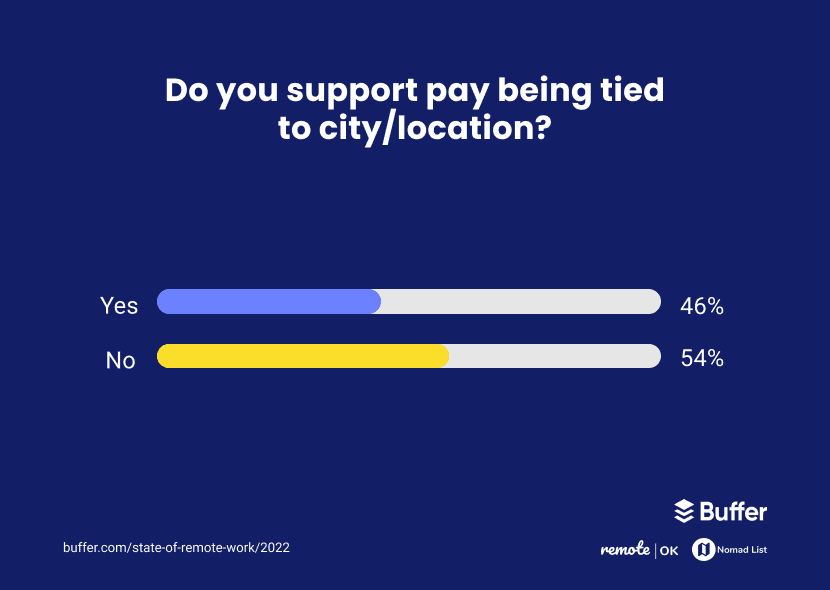
Regardless of how pay is calculated, 73 percent said their pay has not been impacted for switching to remote work.
“Compensation is an ever-evolving thing as companies mature and markets change,” said Joel Gascoigne, co-founder and CEO of Buffer. “We started with location-based pay at Buffer with cost of living bands, but have been slowly moving away from that. Eventually, we won’t factor cost of living at all, instead starting from a point of generosity and offering parity across all salaries. I firmly believe the flexibility this provides to our team will allow them to make choices that are best for them and their family, reducing friction for them to make big decisions knowing we will support them.”
Parting Thoughts
Depending on the area of the world and company policy, many people are still working in conditions we wouldn’t call true remote work because they lack the flexibility and freedom that true remote work offers. In spite of this, more companies seem to have settled into new routines and processes that are working for them.
While it’s not all rosy with remote work - particularly when it comes to employees feeling connected to one another and staving off feelings of loneliness - it’s not all bad, either. People feel overwhelmingly positive about remote work and are now more excited about their job due to working remotely.
We also saw that people are excited about new opportunities in the world of work like the four-day work week and asynchronous work, both of which can help companies rethink the way that work happens.
We hope this report can help you see opportunities for improvement within your own business or organization, and inspire you to think about work differently while we are in this phase of rebuilding the way we work.
Thank you for taking the time to read this year’s report!
View previous reports below to compare the results:
- 2021 State of Remote Work
- 2020 State of Remote Work
- 2019 State of Remote Work
- 2018 State of Remote Work
If you are looking for a remote job we can recommend Remote OK as great places to start; you can also check to see if we are hiring at Buffer.
For questions about this report or data, please reach out to Hailley at press@buffer.com. You are welcome to share and republish all of the charts on this page. This data was collected between October 29th 2021 and November 29th 2021.
190,000+ people like you use Buffer to build their brand on social media every month
Get started for freeNo credit card needed. Free forever.